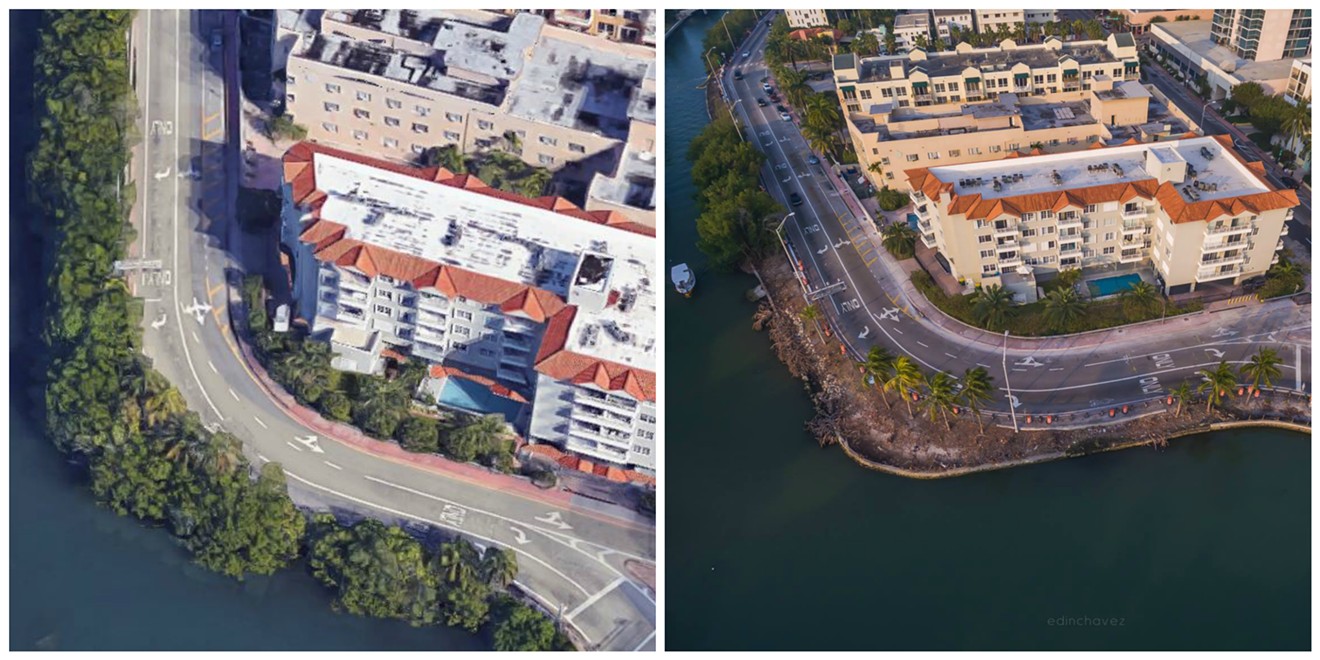Anne Posschelle rides her bike to and from work every day on the tree-lined, waterside Indian Creek Drive. But one night last week, as she neared the curve by 26th Street, she was horrified to see that almost all of the foliage — including protected mangroves — had vanished.
"I was like, Whoa, wait a minute. It's all gone," she says.
Dozens of trees once lined that part of the roadway. Now only a handful of palms remain, and stumps dot the grass. Posschelle and other locals are outraged. They say the vegetation was key to preventing erosion and providing a home for wildlife.
"It was like a massacre," local activist Michael DeFilippi says. "There were so many trees, and that canopy was lost." Miami Beach spokesperson Melissa Berthier confirms the city removed about 80 trees. Berthier says the city had to cut down the trees for a project in partnership with the Florida Department of Transportation that will protect the road from flooding by upgrading the drainage system and constructing a higher seawall along Indian Creek.
The seawall along the western edge of Indian Creek Drive was built at low elevation and was beginning to fail, Berthier adds.
"Most of the mangroves, trees, and other vegetation along this corridor were permitted for removal because they were in conflict with the necessary flood-mitigation work," she says.
The city communicated its plans during public meetings, including to the Marine and Waterfront Protection Authority, and the project's public information officer emailed regular updates to community stakeholders.
But Posschelle, who says she attended one of the meetings and receives the updates, says the changes were presented as tree "trimmings."
"I actually was going to write to the mayor and say, 'This is not tree trimming; this is tree destruction,'" she says.
She and DeFilippi say they understand the city needs to address its flooding issues. But they want it to be done in a more environmentally friendly way. Mangroves filter water, provide nursery areas for fish, and shelter coastal birds.
Those benefits aren't lost on the city, says Berthier, adding that officials have worked to minimize the impacts on the vegetation and to "preserve it as long as possible."
Now that 80 or so trees gone, the city plans to plant 74 new ones, she says. And the area's mangrove canopy will be restored through a living-shoreline concept.
Still, DeFilippi isn't comforted.
"You can't just replace a tree," he says. "Do you know how many years it takes for a canopy to develop?"
[
{
"name": "Air - MediumRectangle - Inline Content - Mobile Display Size",
"component": "19274298",
"insertPoint": "2",
"requiredCountToDisplay": "2"
},{
"name": "Editor Picks",
"component": "17482312",
"insertPoint": "4",
"requiredCountToDisplay": "1"
},{
"name": "Inline Links",
"component": "18711090",
"insertPoint": "8th",
"startingPoint": 8,
"requiredCountToDisplay": "7",
"maxInsertions": 25
},{
"name": "Air - MediumRectangle - Combo - Inline Content",
"component": "17482310",
"insertPoint": "8th",
"startingPoint": 8,
"requiredCountToDisplay": "7",
"maxInsertions": 25
},{
"name": "Inline Links",
"component": "18711090",
"insertPoint": "8th",
"startingPoint": 12,
"requiredCountToDisplay": "11",
"maxInsertions": 25
},{
"name": "Air - Leaderboard Tower - Combo - Inline Content",
"component": "17482313",
"insertPoint": "8th",
"startingPoint": 12,
"requiredCountToDisplay": "11",
"maxInsertions": 25
}
]













